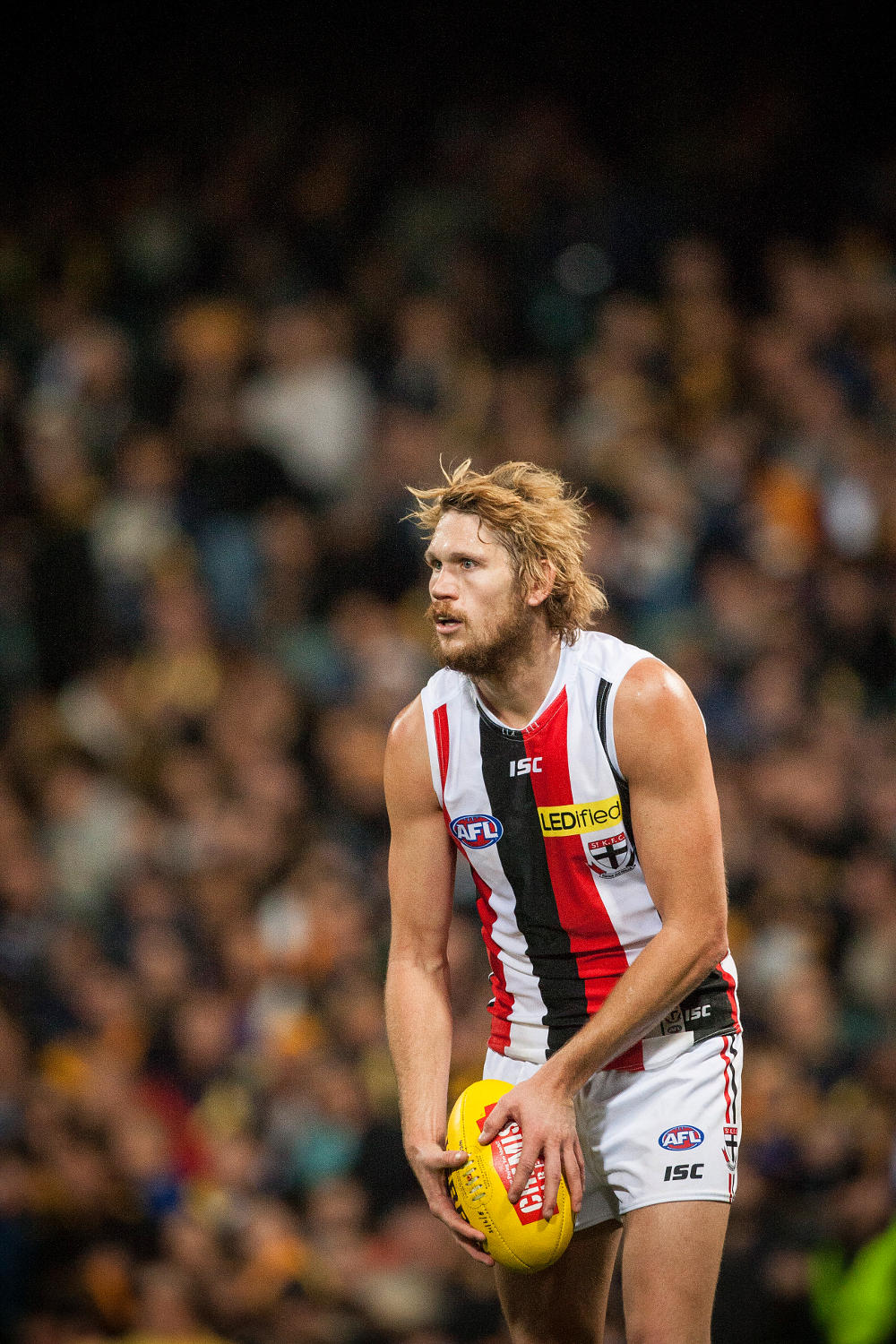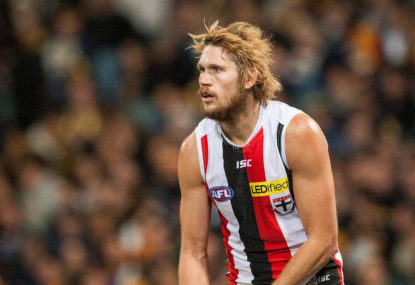Football is back everyone! All is right with the world. They say you should be wary of reading much, if anything, into pre-season footy. Bah, I say.
I loved what I saw of the Saints, and I’m ready to make a fashionably bold call: St Kilda have finals on their radar – if only faintly – in 2016.
Okay, okay, I know it sounds crazy. St Kilda finished in, what, 14th spot last season, and had a percentage of 78? Here me out. I make my sporting bones as a supposedly level-headed, evidence-based writer. What follows is going to bend my standards, if only a little, because I really like what St Kilda are doing.
The middle part of the table could stretch as far as third to 14th this season, and in years like that there is scope for a lot of surprises. Want a hot take? St Kilda could be one of those surprises.
Don’t call it a Power “surge”; nor a Dog “leap”. If it comes off, we’ll have to coin a new phrase. The second coming? The super Saints? That’s a problem for another day.
That 2013 Power team was one of six teams that have managed to enter into finals calculations the year immediately after recording a percentage of 80 or less. The others?
2002 West Coast Eagles
2006 Collingwood
2010 Fremantle
2011 West Coast Eagles
2012 Adelaide
2013 Port Adelaide
Last year’s Western Bulldogs just escaped qualification, recording a percentage of 81.9 in 2014. That’s six teams out of a total of 39 that have recorded a percentage of 80 or less since the year 2000. It isn’t as rare as you may think.
Don’t tell me St Kilda are the fourth-youngest and fifth-least experienced list heading into 2016, either. Port Adelaide were the third-youngest and fourth-least experienced in their surge year, and the Dogs were similarly placed last season (15th and 17th respectively). In fact, all of the sides listed above ranked near the bottom on either or both of the age and experience ladders in the year before they surged. But this is different.
This St Kilda side is the result of four years of meticulous planning, which commenced half way through the reign of Scott Watters. I had a good look at this last year, so let’s not spend a heap of time on list management. The Saints have stacked their deck with draft picks and young discards from other clubs, cut hard at the top of their list, and are now at the point where they will be looking to add established talent to compliment the home grown stuff.
Jake Carlisle was the first of what promises to be half a dozen or so mature age acquisitions in the years ahead. The timing of a new CBA, and the additional salary cap space that this is likely to bring, likely suits the Saints just nicely. They will be in a position to sell a future, and a chance to shape the fortunes of a team overflowing with youngsters.
So I get it, they are young, and mostly unproven. But boy, did I see some great signs in the first half of Saturday’s game against North Melbourne.
This was the only game I watched from start to finish, because it was the only game of the weekend that felt like a real game. These are glorified practise matches afterall, with a secret agreement for all of the away teams to play mostly kids, it seems. Facing a Kangaroo outfit that was practically full strength, the young Saints, who were missing all but their two veteran defenders in Sam Gilbert and Sean Dempster on the mature age front, smacked their opponents around a little bit.
It may have been the exuberance of getting underway for another year, but last season that exuberance was St Kilda’s go-to strategy. Supposedly serious football people said the Saints wouldn’t win a game – a feat reserved for the absolute worst of the worst AFL teams of all time – but under coach Alan Richardson, the Saints made their experience gap up with a game plan built on intensity and pressure.
The Saints were ranked as one of the best sides in the competition on Champion Data’s pressure gauge, meaning their opponents were consistently harassed but also that they forced their style of play on the game. It did blow up on occasion, with the Saints blown out three times last year. There was shades of Hawthorn in the Saints’ ball movement, with St Kilda ranked third for field marks taken and 13th for handballs per game. The Hawks were ranked number one on everything on the per game team statistic tallies, but the two had a near-identical kick/handball ratio (1.31 kicks for every handball).
St Kilda aren’t in the same universe as the Hawks, but there are enough similarities there to suggest this is the look they’re going for. It will take time to develop Hawthorn-like skills. In the mean time, St Kilda’s speed and intensity will serve them well.
That was all on show in the first half on Saturday, but more than that, the Saints were very deliberate when attacking. There was precious little sideways or backwards movement; get the ball, and move it towards your end of the field seemed to be the mantra. The field was left open in general play, and tightened up when the set piece situation demanded it.
St Kilda’s first goal was a perfect example of this. An attacking stoppage on St Kilda’s right wing drew numbers in, but the Saints kept three forwards at or near the goal square ready to lead out once the ball was won. Josh Bruce ended up winning a free kick, but the situation that St Kilda sought to bring about was what forced the one-on-one battle.

Their second quarter was even more impressive, as the Saints completely controlled the pace of the game and built a lead over their much more fancied opponent.
They did run out of legs towards the end of the second quarter, and were somewhat obliterated from that point onwards. North Melbourne won the game by 44 points in the end, as the better skilled and more hardened ‘Roos did what they really should have done from the start. That’s a measure of how well the Saints managed to play their game.
This group may not have the class of some others – like, say, Collingwood, who have a similar age profile through the middle of the ground – but it has pace and endeavour. Richardson’s game plan looks to have evolved in line with the growth of his group, with the additional attacking element necessitating the players being given some license with decision making in a fluid structure. Based on this game – and let’s not over-react, okay? – there’s still a tendency to use the boundary rather than the corridor, but this is likely to do with St Kilda’s underdeveloped defensive unit.
It’s the sort of game plan that, if executed, can give any team a run for their money. Last year, when swarming and pressure was option A, the Saints won just one game (the Western Bulldogs) against a team that finished outside of the bottom six on the ladder. Adding this additional attacking element, with the more mature heads of David Armitage, Jack Steven (who played very little), Leigh Montagna to help shoulder the load, could see the Saints get themselves into more games, early on in the piece.
The other thing to consider in St Kilda’s draw, which is, well, it’s amenable to a surprise push towards the eight. The Saints leave Victoria just once in their final 10 games, and have been gifted the prospect of a clear 4-0 in double ups against Carlton and Essendon. An attacking St Kilda would feel pretty good about knocking off Melbourne twice, too, and have shown on the weekend that they can give North a bit of grief.
Let’s say they split the ledger with North (they play them in Round 7 – who knows what the ‘Roos will do in the first half of this season after their recent issues): that’s seven wins! In a crowded year, 12 wins might be enough to get you into the eight. St Kilda would need to go 5-9 from their remaining 14 games, which may not be likely, but is certainly plausible.
It’s the time of the year that we’re all permitted to have a hot take or two. Sam Kerridge is a lock for the Brownlow after Thursday night, Port Adelaide won’t make the eight, and neither will Sydney. Matthew Pavlich might be the key forward Fremantle are looking for, Troy Chaplin might keep Jack Riewoldt out of the Richmond team, Lance Franklin is past his best, and the new deliberate out of bounds rule is going to cause all sorts of unintended consequences. Wayne Milera is a young Daniel Wells, the Eagles have no hope of winning the flag, and the Geelong discard Dean Gore looks a lock to replace Patrick Dangerfield’s output.
These are all views I’ve seen expressed – some tounge in cheek, but some genuine – over the weekend. Want a hot take with a little bit of evidence, both recent and not so recent, attached? Don’t sleep on the Saints this season.






























































































